Business Environment Report: Tesco plc and Organizational Functions
VerifiedAdded on 2021/02/19
|10
|2792
|47
Report
AI Summary
This report provides a comprehensive analysis of the business environment, focusing on the assessment of different organizational types, including public, private, and voluntary sectors, and their respective purposes. It examines the size and scope of various organizations, using Tesco plc as a case study. The report further explores the interrelationships between different organizational functions such as human resources, finance, marketing, and operations, highlighting how these functions contribute to achieving common goals. It also discusses the advantages and disadvantages of these interrelationships, providing a critical analysis of the complexities of business structures and their impact on organizational performance. The analysis includes a discussion on the impact of macro-environmental factors, internal and external analysis, and the functional, divisional, and matrix structures of the organization.
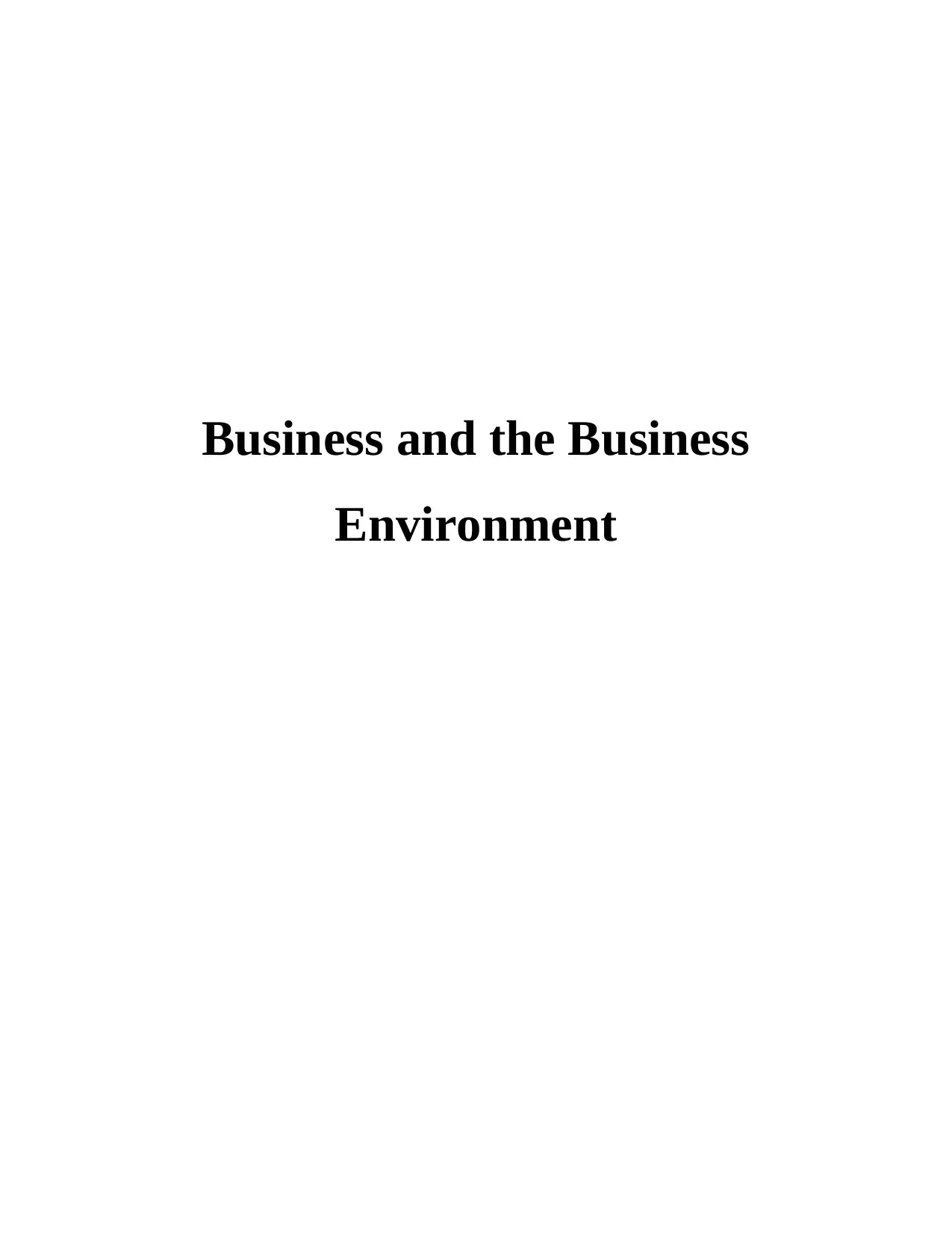
Business and the Business
Environment
Environment
Paraphrase This Document
Need a fresh take? Get an instant paraphrase of this document with our AI Paraphraser
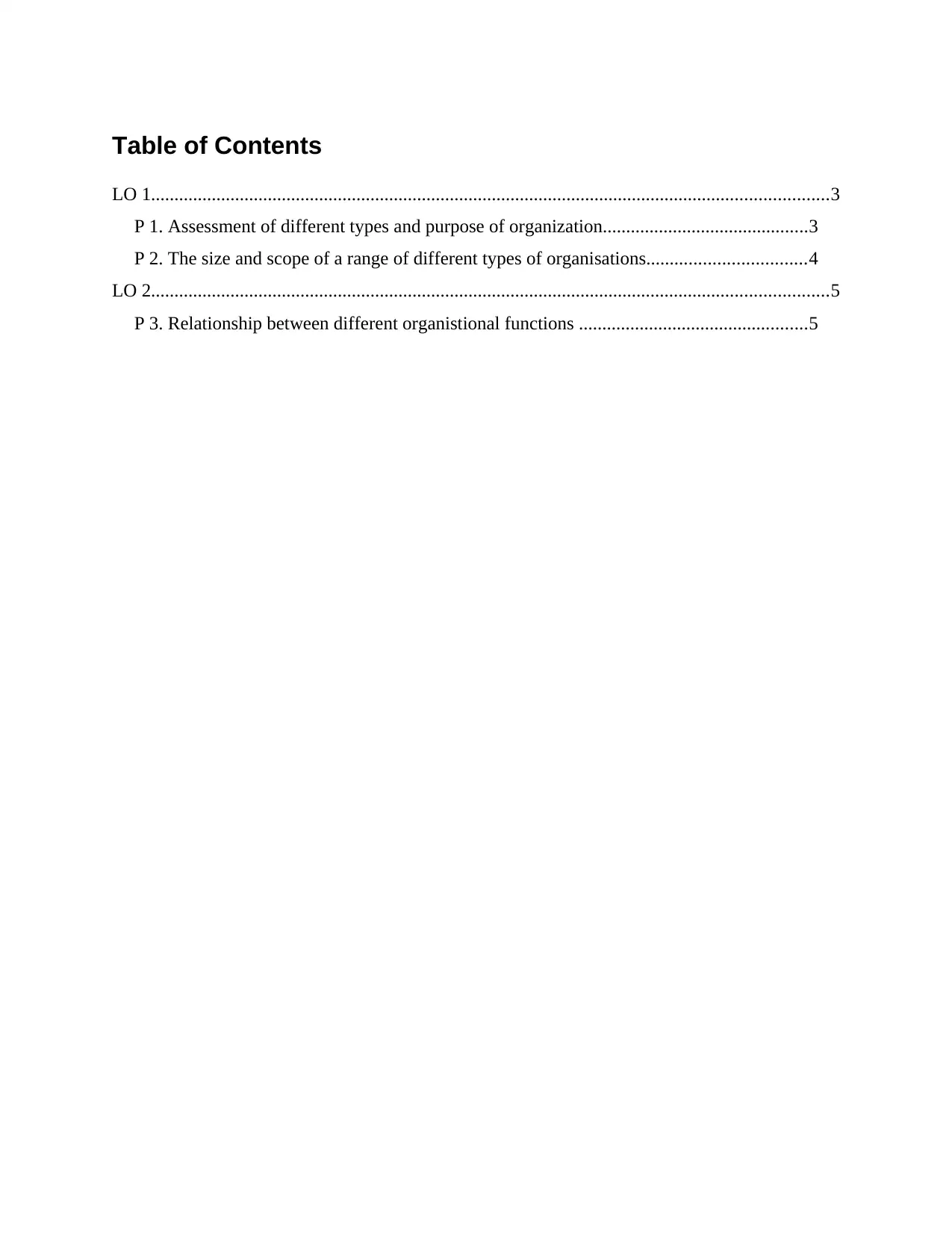
Table of Contents
LO 1.................................................................................................................................................3
P 1. Assessment of different types and purpose of organization............................................3
P 2. The size and scope of a range of different types of organisations..................................4
LO 2.................................................................................................................................................5
P 3. Relationship between different organistional functions .................................................5
LO 1.................................................................................................................................................3
P 1. Assessment of different types and purpose of organization............................................3
P 2. The size and scope of a range of different types of organisations..................................4
LO 2.................................................................................................................................................5
P 3. Relationship between different organistional functions .................................................5
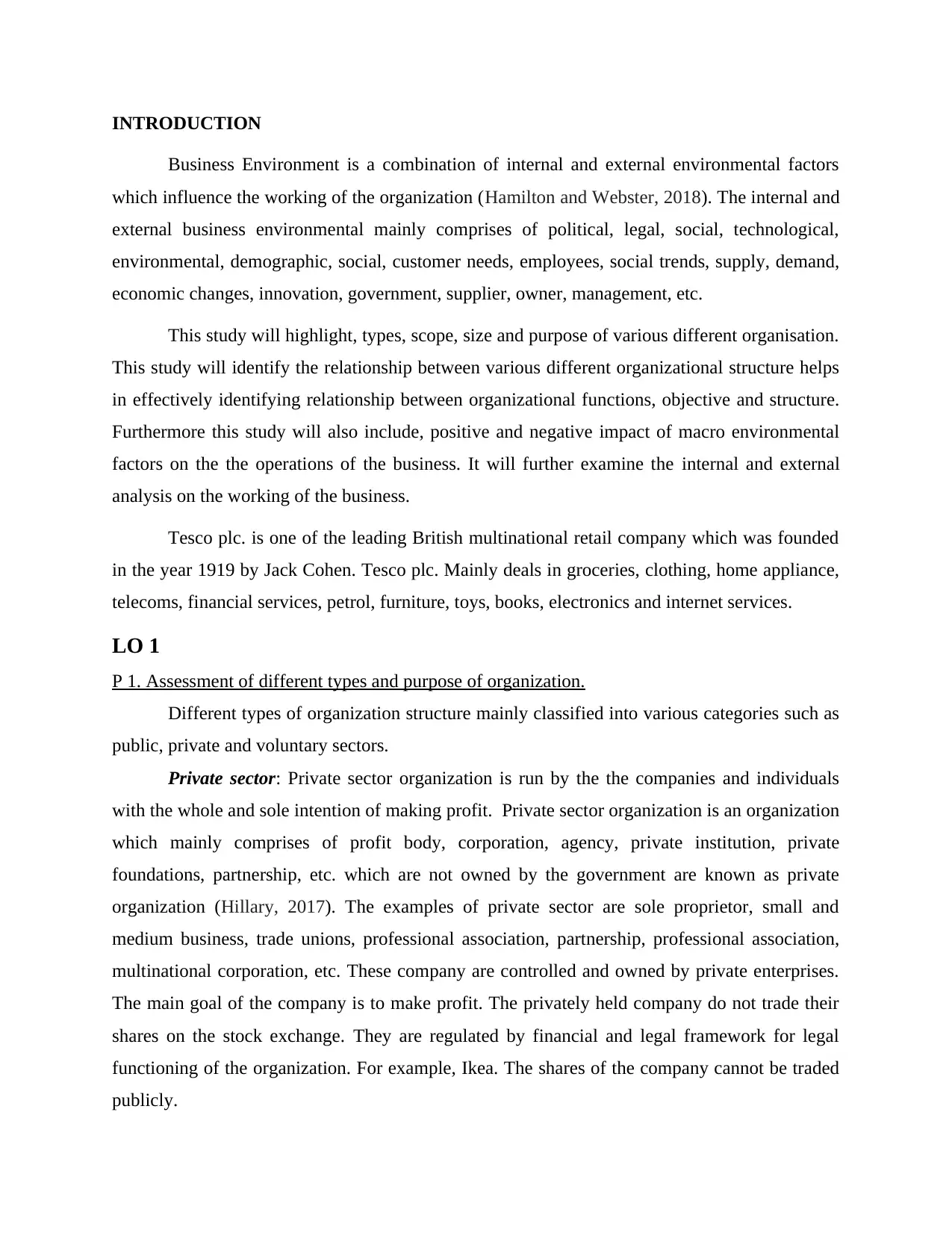
INTRODUCTION
Business Environment is a combination of internal and external environmental factors
which influence the working of the organization (Hamilton and Webster, 2018). The internal and
external business environmental mainly comprises of political, legal, social, technological,
environmental, demographic, social, customer needs, employees, social trends, supply, demand,
economic changes, innovation, government, supplier, owner, management, etc.
This study will highlight, types, scope, size and purpose of various different organisation.
This study will identify the relationship between various different organizational structure helps
in effectively identifying relationship between organizational functions, objective and structure.
Furthermore this study will also include, positive and negative impact of macro environmental
factors on the the operations of the business. It will further examine the internal and external
analysis on the working of the business.
Tesco plc. is one of the leading British multinational retail company which was founded
in the year 1919 by Jack Cohen. Tesco plc. Mainly deals in groceries, clothing, home appliance,
telecoms, financial services, petrol, furniture, toys, books, electronics and internet services.
LO 1
P 1. Assessment of different types and purpose of organization.
Different types of organization structure mainly classified into various categories such as
public, private and voluntary sectors.
Private sector: Private sector organization is run by the the companies and individuals
with the whole and sole intention of making profit. Private sector organization is an organization
which mainly comprises of profit body, corporation, agency, private institution, private
foundations, partnership, etc. which are not owned by the government are known as private
organization (Hillary, 2017). The examples of private sector are sole proprietor, small and
medium business, trade unions, professional association, partnership, professional association,
multinational corporation, etc. These company are controlled and owned by private enterprises.
The main goal of the company is to make profit. The privately held company do not trade their
shares on the stock exchange. They are regulated by financial and legal framework for legal
functioning of the organization. For example, Ikea. The shares of the company cannot be traded
publicly.
Business Environment is a combination of internal and external environmental factors
which influence the working of the organization (Hamilton and Webster, 2018). The internal and
external business environmental mainly comprises of political, legal, social, technological,
environmental, demographic, social, customer needs, employees, social trends, supply, demand,
economic changes, innovation, government, supplier, owner, management, etc.
This study will highlight, types, scope, size and purpose of various different organisation.
This study will identify the relationship between various different organizational structure helps
in effectively identifying relationship between organizational functions, objective and structure.
Furthermore this study will also include, positive and negative impact of macro environmental
factors on the the operations of the business. It will further examine the internal and external
analysis on the working of the business.
Tesco plc. is one of the leading British multinational retail company which was founded
in the year 1919 by Jack Cohen. Tesco plc. Mainly deals in groceries, clothing, home appliance,
telecoms, financial services, petrol, furniture, toys, books, electronics and internet services.
LO 1
P 1. Assessment of different types and purpose of organization.
Different types of organization structure mainly classified into various categories such as
public, private and voluntary sectors.
Private sector: Private sector organization is run by the the companies and individuals
with the whole and sole intention of making profit. Private sector organization is an organization
which mainly comprises of profit body, corporation, agency, private institution, private
foundations, partnership, etc. which are not owned by the government are known as private
organization (Hillary, 2017). The examples of private sector are sole proprietor, small and
medium business, trade unions, professional association, partnership, professional association,
multinational corporation, etc. These company are controlled and owned by private enterprises.
The main goal of the company is to make profit. The privately held company do not trade their
shares on the stock exchange. They are regulated by financial and legal framework for legal
functioning of the organization. For example, Ikea. The shares of the company cannot be traded
publicly.
⊘ This is a preview!⊘
Do you want full access?
Subscribe today to unlock all pages.

Trusted by 1+ million students worldwide
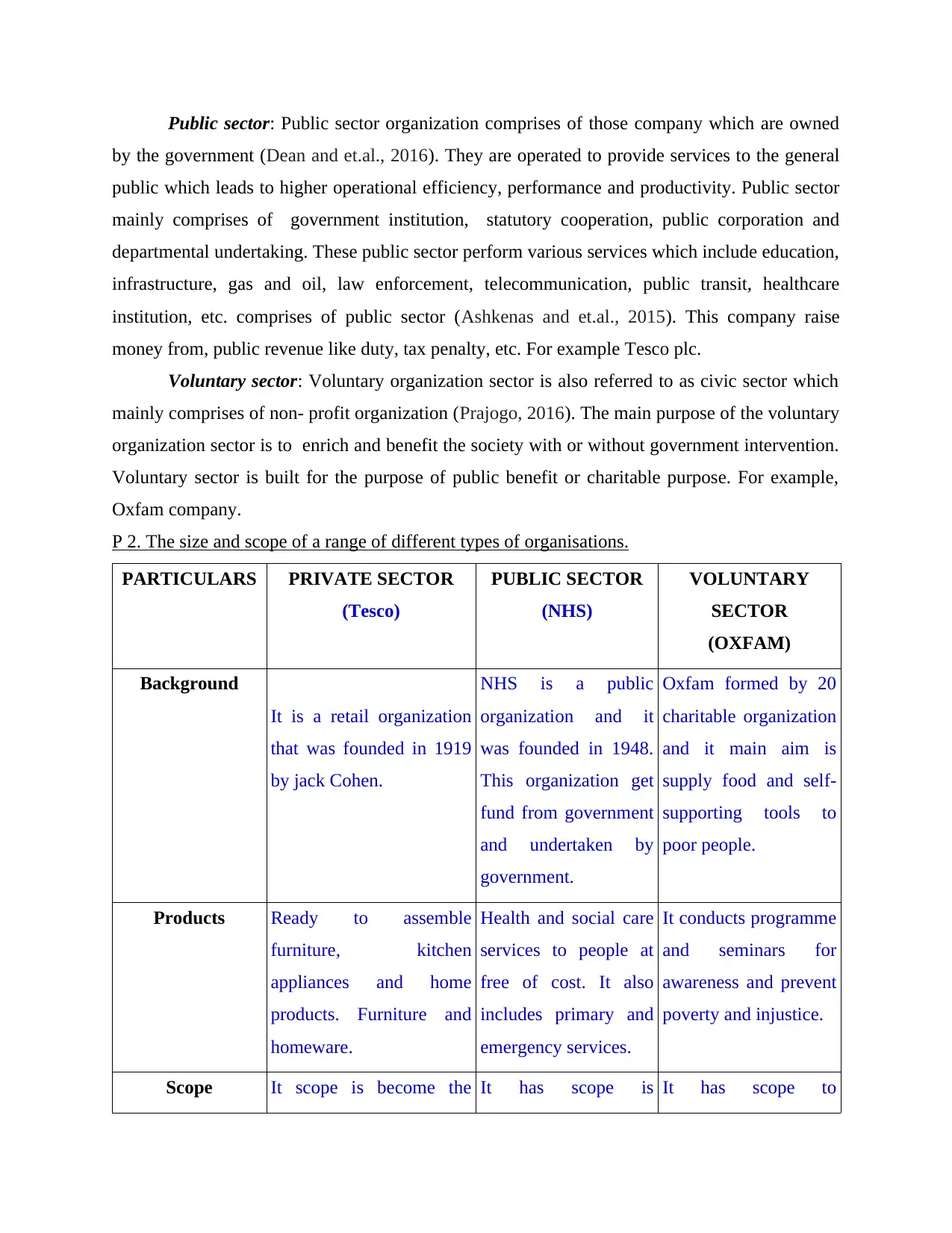
Public sector: Public sector organization comprises of those company which are owned
by the government (Dean and et.al., 2016). They are operated to provide services to the general
public which leads to higher operational efficiency, performance and productivity. Public sector
mainly comprises of government institution, statutory cooperation, public corporation and
departmental undertaking. These public sector perform various services which include education,
infrastructure, gas and oil, law enforcement, telecommunication, public transit, healthcare
institution, etc. comprises of public sector (Ashkenas and et.al., 2015). This company raise
money from, public revenue like duty, tax penalty, etc. For example Tesco plc.
Voluntary sector: Voluntary organization sector is also referred to as civic sector which
mainly comprises of non- profit organization (Prajogo, 2016). The main purpose of the voluntary
organization sector is to enrich and benefit the society with or without government intervention.
Voluntary sector is built for the purpose of public benefit or charitable purpose. For example,
Oxfam company.
P 2. The size and scope of a range of different types of organisations.
PARTICULARS PRIVATE SECTOR
(Tesco)
PUBLIC SECTOR
(NHS)
VOLUNTARY
SECTOR
(OXFAM)
Background
It is a retail organization
that was founded in 1919
by jack Cohen.
NHS is a public
organization and it
was founded in 1948.
This organization get
fund from government
and undertaken by
government.
Oxfam formed by 20
charitable organization
and it main aim is
supply food and self-
supporting tools to
poor people.
Products Ready to assemble
furniture, kitchen
appliances and home
products. Furniture and
homeware.
Health and social care
services to people at
free of cost. It also
includes primary and
emergency services.
It conducts programme
and seminars for
awareness and prevent
poverty and injustice.
Scope It scope is become the It has scope is It has scope to
by the government (Dean and et.al., 2016). They are operated to provide services to the general
public which leads to higher operational efficiency, performance and productivity. Public sector
mainly comprises of government institution, statutory cooperation, public corporation and
departmental undertaking. These public sector perform various services which include education,
infrastructure, gas and oil, law enforcement, telecommunication, public transit, healthcare
institution, etc. comprises of public sector (Ashkenas and et.al., 2015). This company raise
money from, public revenue like duty, tax penalty, etc. For example Tesco plc.
Voluntary sector: Voluntary organization sector is also referred to as civic sector which
mainly comprises of non- profit organization (Prajogo, 2016). The main purpose of the voluntary
organization sector is to enrich and benefit the society with or without government intervention.
Voluntary sector is built for the purpose of public benefit or charitable purpose. For example,
Oxfam company.
P 2. The size and scope of a range of different types of organisations.
PARTICULARS PRIVATE SECTOR
(Tesco)
PUBLIC SECTOR
(NHS)
VOLUNTARY
SECTOR
(OXFAM)
Background
It is a retail organization
that was founded in 1919
by jack Cohen.
NHS is a public
organization and it
was founded in 1948.
This organization get
fund from government
and undertaken by
government.
Oxfam formed by 20
charitable organization
and it main aim is
supply food and self-
supporting tools to
poor people.
Products Ready to assemble
furniture, kitchen
appliances and home
products. Furniture and
homeware.
Health and social care
services to people at
free of cost. It also
includes primary and
emergency services.
It conducts programme
and seminars for
awareness and prevent
poverty and injustice.
Scope It scope is become the It has scope is It has scope to
Paraphrase This Document
Need a fresh take? Get an instant paraphrase of this document with our AI Paraphraser
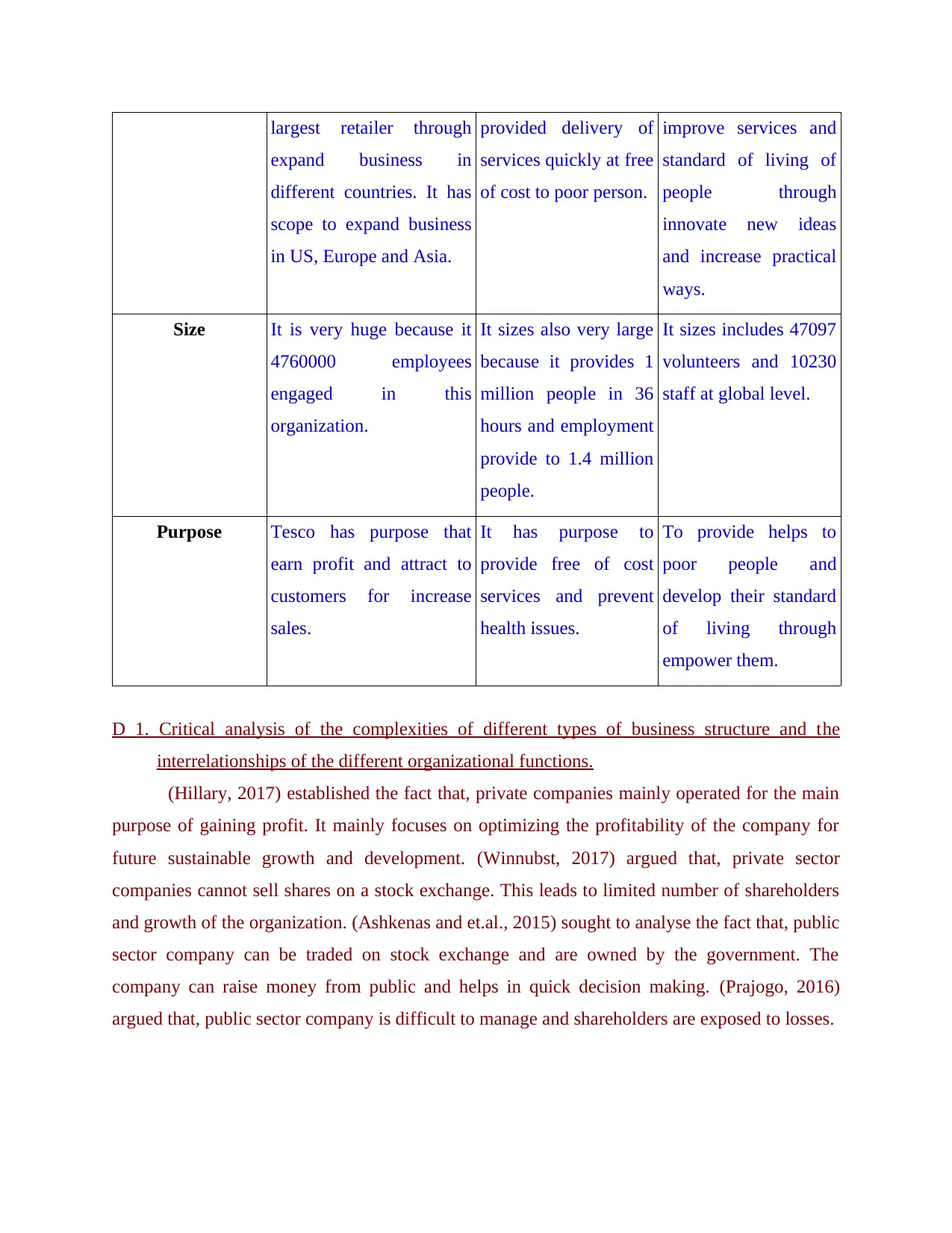
largest retailer through
expand business in
different countries. It has
scope to expand business
in US, Europe and Asia.
provided delivery of
services quickly at free
of cost to poor person.
improve services and
standard of living of
people through
innovate new ideas
and increase practical
ways.
Size It is very huge because it
4760000 employees
engaged in this
organization.
It sizes also very large
because it provides 1
million people in 36
hours and employment
provide to 1.4 million
people.
It sizes includes 47097
volunteers and 10230
staff at global level.
Purpose Tesco has purpose that
earn profit and attract to
customers for increase
sales.
It has purpose to
provide free of cost
services and prevent
health issues.
To provide helps to
poor people and
develop their standard
of living through
empower them.
D 1. Critical analysis of the complexities of different types of business structure and the
interrelationships of the different organizational functions.
(Hillary, 2017) established the fact that, private companies mainly operated for the main
purpose of gaining profit. It mainly focuses on optimizing the profitability of the company for
future sustainable growth and development. (Winnubst, 2017) argued that, private sector
companies cannot sell shares on a stock exchange. This leads to limited number of shareholders
and growth of the organization. (Ashkenas and et.al., 2015) sought to analyse the fact that, public
sector company can be traded on stock exchange and are owned by the government. The
company can raise money from public and helps in quick decision making. (Prajogo, 2016)
argued that, public sector company is difficult to manage and shareholders are exposed to losses.
expand business in
different countries. It has
scope to expand business
in US, Europe and Asia.
provided delivery of
services quickly at free
of cost to poor person.
improve services and
standard of living of
people through
innovate new ideas
and increase practical
ways.
Size It is very huge because it
4760000 employees
engaged in this
organization.
It sizes also very large
because it provides 1
million people in 36
hours and employment
provide to 1.4 million
people.
It sizes includes 47097
volunteers and 10230
staff at global level.
Purpose Tesco has purpose that
earn profit and attract to
customers for increase
sales.
It has purpose to
provide free of cost
services and prevent
health issues.
To provide helps to
poor people and
develop their standard
of living through
empower them.
D 1. Critical analysis of the complexities of different types of business structure and the
interrelationships of the different organizational functions.
(Hillary, 2017) established the fact that, private companies mainly operated for the main
purpose of gaining profit. It mainly focuses on optimizing the profitability of the company for
future sustainable growth and development. (Winnubst, 2017) argued that, private sector
companies cannot sell shares on a stock exchange. This leads to limited number of shareholders
and growth of the organization. (Ashkenas and et.al., 2015) sought to analyse the fact that, public
sector company can be traded on stock exchange and are owned by the government. The
company can raise money from public and helps in quick decision making. (Prajogo, 2016)
argued that, public sector company is difficult to manage and shareholders are exposed to losses.
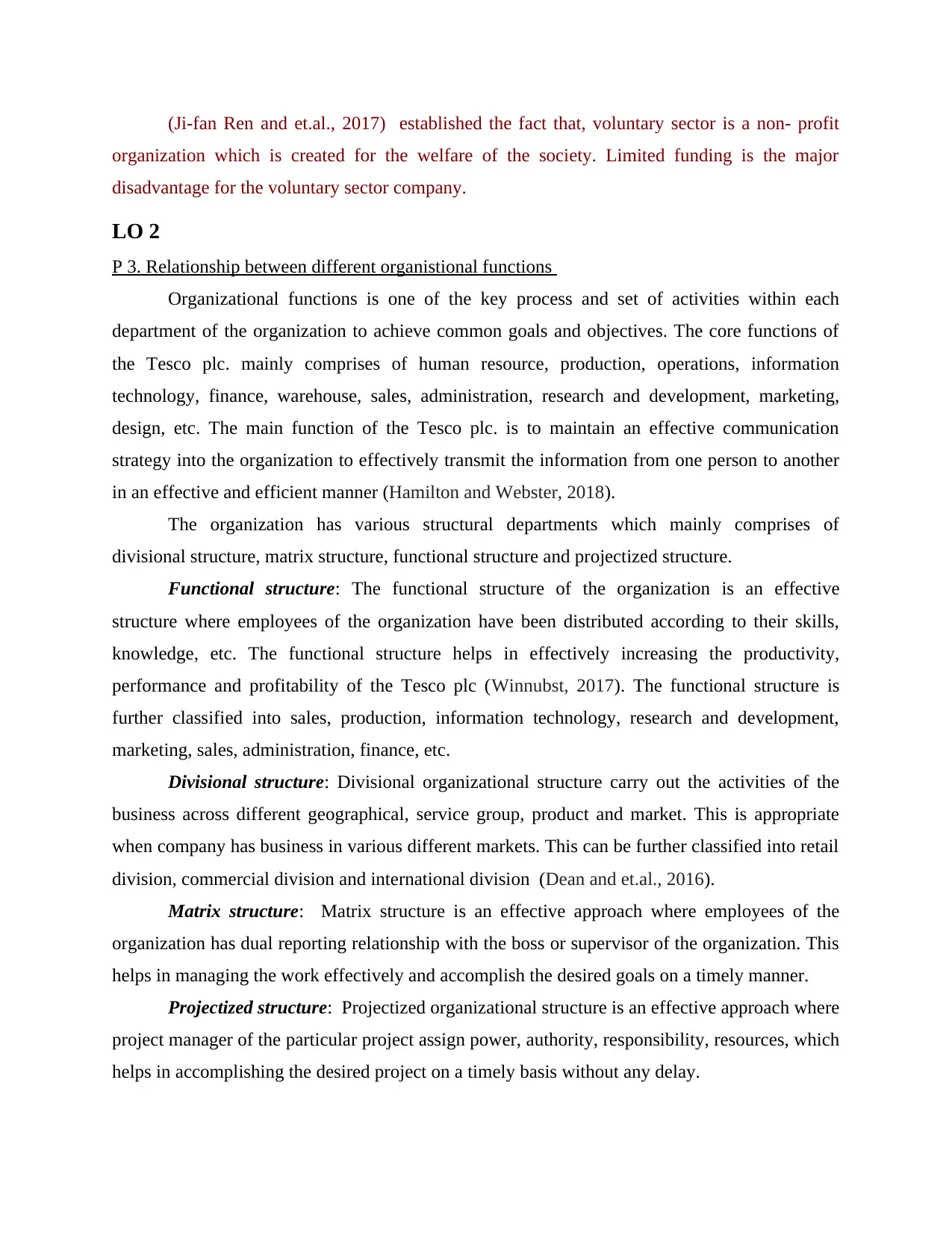
(Ji-fan Ren and et.al., 2017) established the fact that, voluntary sector is a non- profit
organization which is created for the welfare of the society. Limited funding is the major
disadvantage for the voluntary sector company.
LO 2
P 3. Relationship between different organistional functions
Organizational functions is one of the key process and set of activities within each
department of the organization to achieve common goals and objectives. The core functions of
the Tesco plc. mainly comprises of human resource, production, operations, information
technology, finance, warehouse, sales, administration, research and development, marketing,
design, etc. The main function of the Tesco plc. is to maintain an effective communication
strategy into the organization to effectively transmit the information from one person to another
in an effective and efficient manner (Hamilton and Webster, 2018).
The organization has various structural departments which mainly comprises of
divisional structure, matrix structure, functional structure and projectized structure.
Functional structure: The functional structure of the organization is an effective
structure where employees of the organization have been distributed according to their skills,
knowledge, etc. The functional structure helps in effectively increasing the productivity,
performance and profitability of the Tesco plc (Winnubst, 2017). The functional structure is
further classified into sales, production, information technology, research and development,
marketing, sales, administration, finance, etc.
Divisional structure: Divisional organizational structure carry out the activities of the
business across different geographical, service group, product and market. This is appropriate
when company has business in various different markets. This can be further classified into retail
division, commercial division and international division (Dean and et.al., 2016).
Matrix structure: Matrix structure is an effective approach where employees of the
organization has dual reporting relationship with the boss or supervisor of the organization. This
helps in managing the work effectively and accomplish the desired goals on a timely manner.
Projectized structure: Projectized organizational structure is an effective approach where
project manager of the particular project assign power, authority, responsibility, resources, which
helps in accomplishing the desired project on a timely basis without any delay.
organization which is created for the welfare of the society. Limited funding is the major
disadvantage for the voluntary sector company.
LO 2
P 3. Relationship between different organistional functions
Organizational functions is one of the key process and set of activities within each
department of the organization to achieve common goals and objectives. The core functions of
the Tesco plc. mainly comprises of human resource, production, operations, information
technology, finance, warehouse, sales, administration, research and development, marketing,
design, etc. The main function of the Tesco plc. is to maintain an effective communication
strategy into the organization to effectively transmit the information from one person to another
in an effective and efficient manner (Hamilton and Webster, 2018).
The organization has various structural departments which mainly comprises of
divisional structure, matrix structure, functional structure and projectized structure.
Functional structure: The functional structure of the organization is an effective
structure where employees of the organization have been distributed according to their skills,
knowledge, etc. The functional structure helps in effectively increasing the productivity,
performance and profitability of the Tesco plc (Winnubst, 2017). The functional structure is
further classified into sales, production, information technology, research and development,
marketing, sales, administration, finance, etc.
Divisional structure: Divisional organizational structure carry out the activities of the
business across different geographical, service group, product and market. This is appropriate
when company has business in various different markets. This can be further classified into retail
division, commercial division and international division (Dean and et.al., 2016).
Matrix structure: Matrix structure is an effective approach where employees of the
organization has dual reporting relationship with the boss or supervisor of the organization. This
helps in managing the work effectively and accomplish the desired goals on a timely manner.
Projectized structure: Projectized organizational structure is an effective approach where
project manager of the particular project assign power, authority, responsibility, resources, which
helps in accomplishing the desired project on a timely basis without any delay.
⊘ This is a preview!⊘
Do you want full access?
Subscribe today to unlock all pages.

Trusted by 1+ million students worldwide
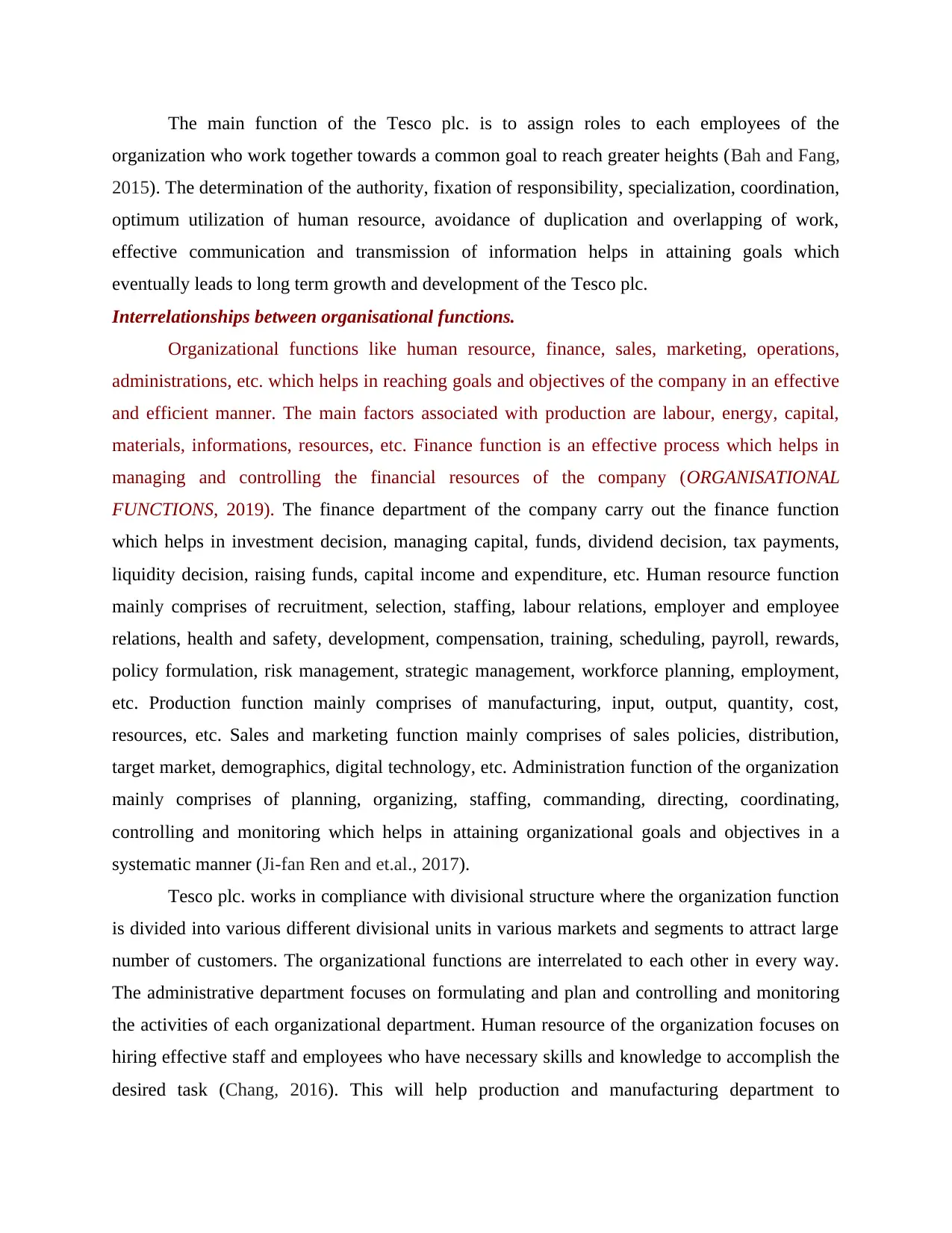
The main function of the Tesco plc. is to assign roles to each employees of the
organization who work together towards a common goal to reach greater heights (Bah and Fang,
2015). The determination of the authority, fixation of responsibility, specialization, coordination,
optimum utilization of human resource, avoidance of duplication and overlapping of work,
effective communication and transmission of information helps in attaining goals which
eventually leads to long term growth and development of the Tesco plc.
Interrelationships between organisational functions.
Organizational functions like human resource, finance, sales, marketing, operations,
administrations, etc. which helps in reaching goals and objectives of the company in an effective
and efficient manner. The main factors associated with production are labour, energy, capital,
materials, informations, resources, etc. Finance function is an effective process which helps in
managing and controlling the financial resources of the company (ORGANISATIONAL
FUNCTIONS, 2019). The finance department of the company carry out the finance function
which helps in investment decision, managing capital, funds, dividend decision, tax payments,
liquidity decision, raising funds, capital income and expenditure, etc. Human resource function
mainly comprises of recruitment, selection, staffing, labour relations, employer and employee
relations, health and safety, development, compensation, training, scheduling, payroll, rewards,
policy formulation, risk management, strategic management, workforce planning, employment,
etc. Production function mainly comprises of manufacturing, input, output, quantity, cost,
resources, etc. Sales and marketing function mainly comprises of sales policies, distribution,
target market, demographics, digital technology, etc. Administration function of the organization
mainly comprises of planning, organizing, staffing, commanding, directing, coordinating,
controlling and monitoring which helps in attaining organizational goals and objectives in a
systematic manner (Ji-fan Ren and et.al., 2017).
Tesco plc. works in compliance with divisional structure where the organization function
is divided into various different divisional units in various markets and segments to attract large
number of customers. The organizational functions are interrelated to each other in every way.
The administrative department focuses on formulating and plan and controlling and monitoring
the activities of each organizational department. Human resource of the organization focuses on
hiring effective staff and employees who have necessary skills and knowledge to accomplish the
desired task (Chang, 2016). This will help production and manufacturing department to
organization who work together towards a common goal to reach greater heights (Bah and Fang,
2015). The determination of the authority, fixation of responsibility, specialization, coordination,
optimum utilization of human resource, avoidance of duplication and overlapping of work,
effective communication and transmission of information helps in attaining goals which
eventually leads to long term growth and development of the Tesco plc.
Interrelationships between organisational functions.
Organizational functions like human resource, finance, sales, marketing, operations,
administrations, etc. which helps in reaching goals and objectives of the company in an effective
and efficient manner. The main factors associated with production are labour, energy, capital,
materials, informations, resources, etc. Finance function is an effective process which helps in
managing and controlling the financial resources of the company (ORGANISATIONAL
FUNCTIONS, 2019). The finance department of the company carry out the finance function
which helps in investment decision, managing capital, funds, dividend decision, tax payments,
liquidity decision, raising funds, capital income and expenditure, etc. Human resource function
mainly comprises of recruitment, selection, staffing, labour relations, employer and employee
relations, health and safety, development, compensation, training, scheduling, payroll, rewards,
policy formulation, risk management, strategic management, workforce planning, employment,
etc. Production function mainly comprises of manufacturing, input, output, quantity, cost,
resources, etc. Sales and marketing function mainly comprises of sales policies, distribution,
target market, demographics, digital technology, etc. Administration function of the organization
mainly comprises of planning, organizing, staffing, commanding, directing, coordinating,
controlling and monitoring which helps in attaining organizational goals and objectives in a
systematic manner (Ji-fan Ren and et.al., 2017).
Tesco plc. works in compliance with divisional structure where the organization function
is divided into various different divisional units in various markets and segments to attract large
number of customers. The organizational functions are interrelated to each other in every way.
The administrative department focuses on formulating and plan and controlling and monitoring
the activities of each organizational department. Human resource of the organization focuses on
hiring effective staff and employees who have necessary skills and knowledge to accomplish the
desired task (Chang, 2016). This will help production and manufacturing department to
Paraphrase This Document
Need a fresh take? Get an instant paraphrase of this document with our AI Paraphraser
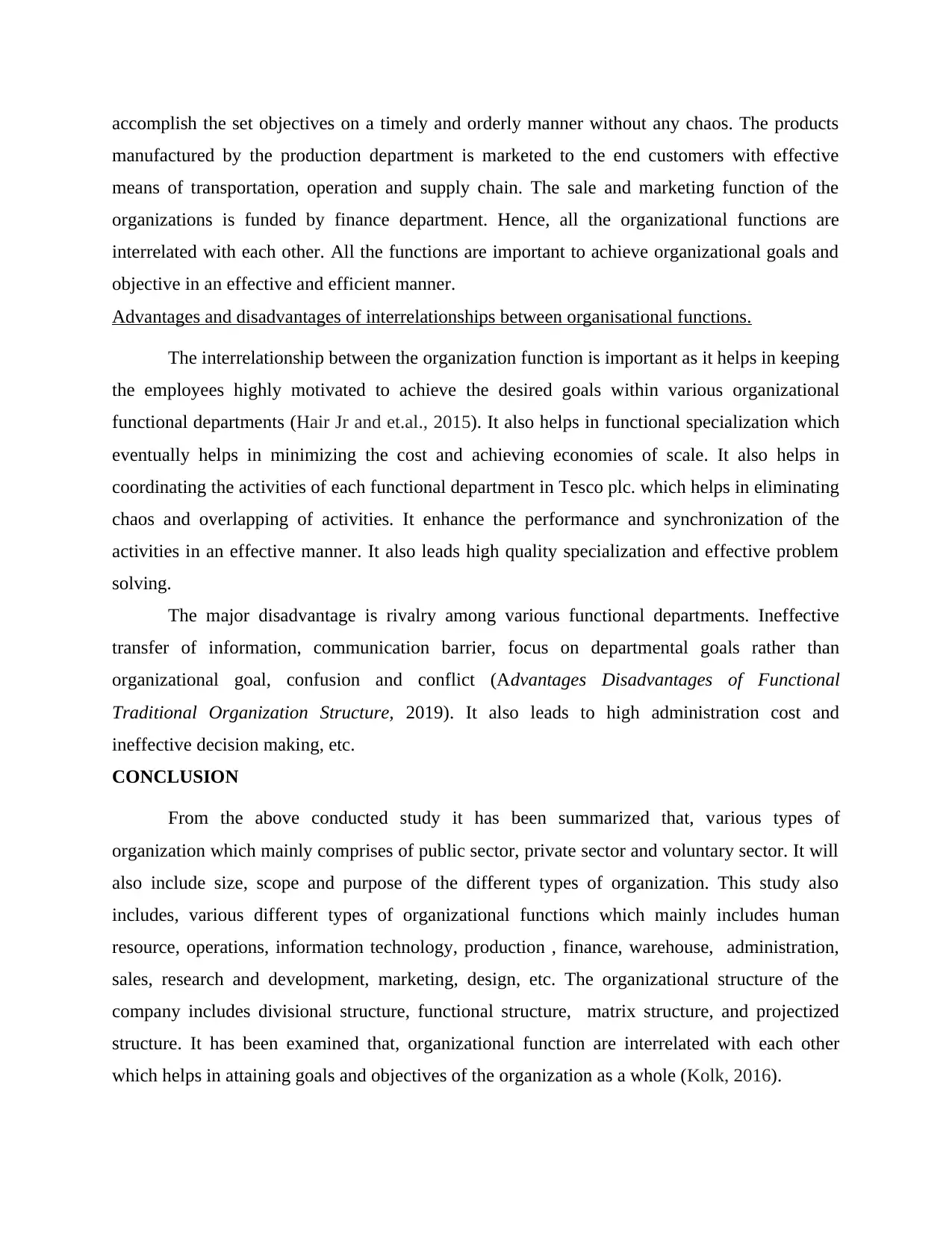
accomplish the set objectives on a timely and orderly manner without any chaos. The products
manufactured by the production department is marketed to the end customers with effective
means of transportation, operation and supply chain. The sale and marketing function of the
organizations is funded by finance department. Hence, all the organizational functions are
interrelated with each other. All the functions are important to achieve organizational goals and
objective in an effective and efficient manner.
Advantages and disadvantages of interrelationships between organisational functions.
The interrelationship between the organization function is important as it helps in keeping
the employees highly motivated to achieve the desired goals within various organizational
functional departments (Hair Jr and et.al., 2015). It also helps in functional specialization which
eventually helps in minimizing the cost and achieving economies of scale. It also helps in
coordinating the activities of each functional department in Tesco plc. which helps in eliminating
chaos and overlapping of activities. It enhance the performance and synchronization of the
activities in an effective manner. It also leads high quality specialization and effective problem
solving.
The major disadvantage is rivalry among various functional departments. Ineffective
transfer of information, communication barrier, focus on departmental goals rather than
organizational goal, confusion and conflict (Advantages Disadvantages of Functional
Traditional Organization Structure, 2019). It also leads to high administration cost and
ineffective decision making, etc.
CONCLUSION
From the above conducted study it has been summarized that, various types of
organization which mainly comprises of public sector, private sector and voluntary sector. It will
also include size, scope and purpose of the different types of organization. This study also
includes, various different types of organizational functions which mainly includes human
resource, operations, information technology, production , finance, warehouse, administration,
sales, research and development, marketing, design, etc. The organizational structure of the
company includes divisional structure, functional structure, matrix structure, and projectized
structure. It has been examined that, organizational function are interrelated with each other
which helps in attaining goals and objectives of the organization as a whole (Kolk, 2016).
manufactured by the production department is marketed to the end customers with effective
means of transportation, operation and supply chain. The sale and marketing function of the
organizations is funded by finance department. Hence, all the organizational functions are
interrelated with each other. All the functions are important to achieve organizational goals and
objective in an effective and efficient manner.
Advantages and disadvantages of interrelationships between organisational functions.
The interrelationship between the organization function is important as it helps in keeping
the employees highly motivated to achieve the desired goals within various organizational
functional departments (Hair Jr and et.al., 2015). It also helps in functional specialization which
eventually helps in minimizing the cost and achieving economies of scale. It also helps in
coordinating the activities of each functional department in Tesco plc. which helps in eliminating
chaos and overlapping of activities. It enhance the performance and synchronization of the
activities in an effective manner. It also leads high quality specialization and effective problem
solving.
The major disadvantage is rivalry among various functional departments. Ineffective
transfer of information, communication barrier, focus on departmental goals rather than
organizational goal, confusion and conflict (Advantages Disadvantages of Functional
Traditional Organization Structure, 2019). It also leads to high administration cost and
ineffective decision making, etc.
CONCLUSION
From the above conducted study it has been summarized that, various types of
organization which mainly comprises of public sector, private sector and voluntary sector. It will
also include size, scope and purpose of the different types of organization. This study also
includes, various different types of organizational functions which mainly includes human
resource, operations, information technology, production , finance, warehouse, administration,
sales, research and development, marketing, design, etc. The organizational structure of the
company includes divisional structure, functional structure, matrix structure, and projectized
structure. It has been examined that, organizational function are interrelated with each other
which helps in attaining goals and objectives of the organization as a whole (Kolk, 2016).
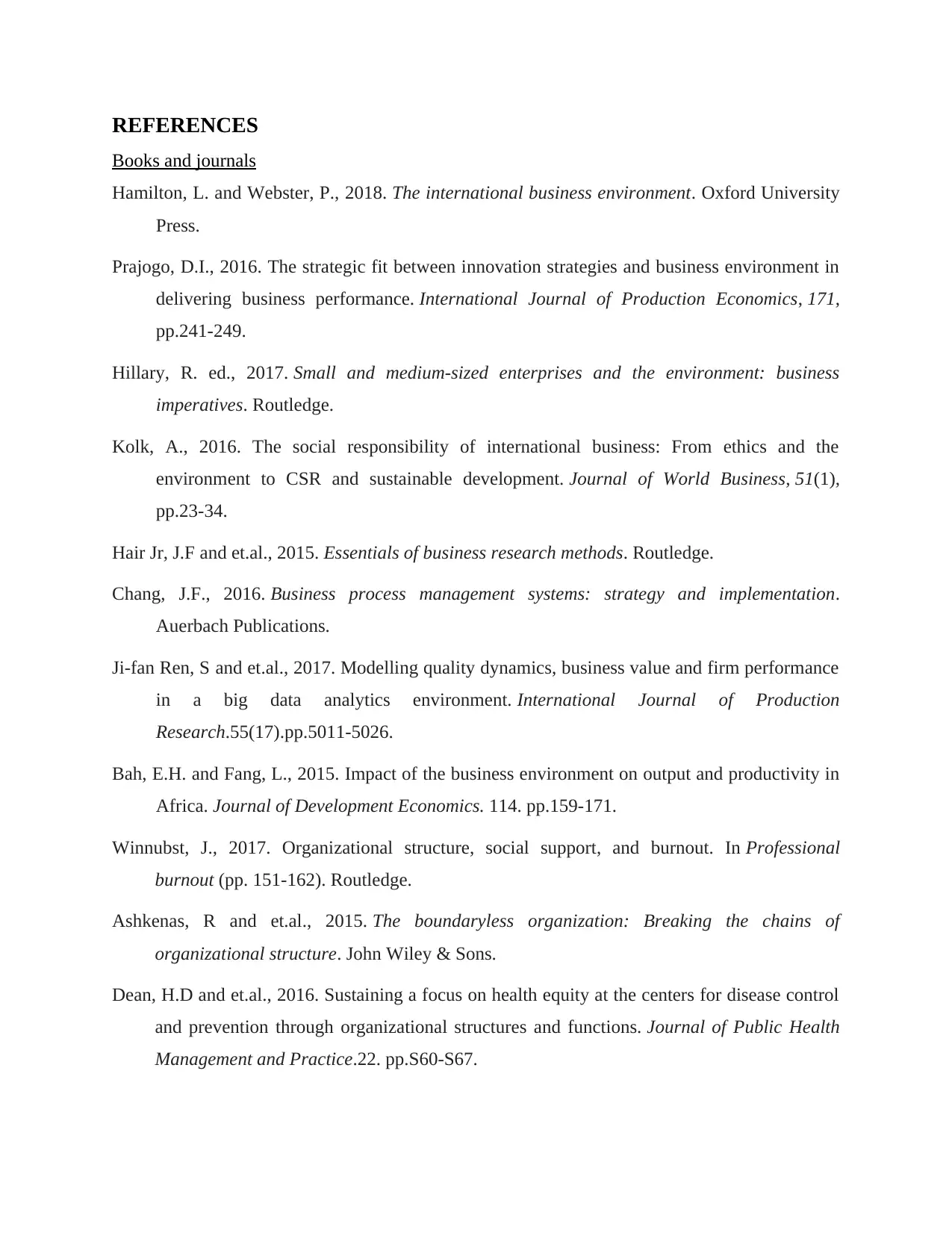
REFERENCES
Books and journals
Hamilton, L. and Webster, P., 2018. The international business environment. Oxford University
Press.
Prajogo, D.I., 2016. The strategic fit between innovation strategies and business environment in
delivering business performance. International Journal of Production Economics, 171,
pp.241-249.
Hillary, R. ed., 2017. Small and medium-sized enterprises and the environment: business
imperatives. Routledge.
Kolk, A., 2016. The social responsibility of international business: From ethics and the
environment to CSR and sustainable development. Journal of World Business, 51(1),
pp.23-34.
Hair Jr, J.F and et.al., 2015. Essentials of business research methods. Routledge.
Chang, J.F., 2016. Business process management systems: strategy and implementation.
Auerbach Publications.
Ji-fan Ren, S and et.al., 2017. Modelling quality dynamics, business value and firm performance
in a big data analytics environment. International Journal of Production
Research.55(17).pp.5011-5026.
Bah, E.H. and Fang, L., 2015. Impact of the business environment on output and productivity in
Africa. Journal of Development Economics. 114. pp.159-171.
Winnubst, J., 2017. Organizational structure, social support, and burnout. In Professional
burnout (pp. 151-162). Routledge.
Ashkenas, R and et.al., 2015. The boundaryless organization: Breaking the chains of
organizational structure. John Wiley & Sons.
Dean, H.D and et.al., 2016. Sustaining a focus on health equity at the centers for disease control
and prevention through organizational structures and functions. Journal of Public Health
Management and Practice.22. pp.S60-S67.
Books and journals
Hamilton, L. and Webster, P., 2018. The international business environment. Oxford University
Press.
Prajogo, D.I., 2016. The strategic fit between innovation strategies and business environment in
delivering business performance. International Journal of Production Economics, 171,
pp.241-249.
Hillary, R. ed., 2017. Small and medium-sized enterprises and the environment: business
imperatives. Routledge.
Kolk, A., 2016. The social responsibility of international business: From ethics and the
environment to CSR and sustainable development. Journal of World Business, 51(1),
pp.23-34.
Hair Jr, J.F and et.al., 2015. Essentials of business research methods. Routledge.
Chang, J.F., 2016. Business process management systems: strategy and implementation.
Auerbach Publications.
Ji-fan Ren, S and et.al., 2017. Modelling quality dynamics, business value and firm performance
in a big data analytics environment. International Journal of Production
Research.55(17).pp.5011-5026.
Bah, E.H. and Fang, L., 2015. Impact of the business environment on output and productivity in
Africa. Journal of Development Economics. 114. pp.159-171.
Winnubst, J., 2017. Organizational structure, social support, and burnout. In Professional
burnout (pp. 151-162). Routledge.
Ashkenas, R and et.al., 2015. The boundaryless organization: Breaking the chains of
organizational structure. John Wiley & Sons.
Dean, H.D and et.al., 2016. Sustaining a focus on health equity at the centers for disease control
and prevention through organizational structures and functions. Journal of Public Health
Management and Practice.22. pp.S60-S67.
⊘ This is a preview!⊘
Do you want full access?
Subscribe today to unlock all pages.

Trusted by 1+ million students worldwide
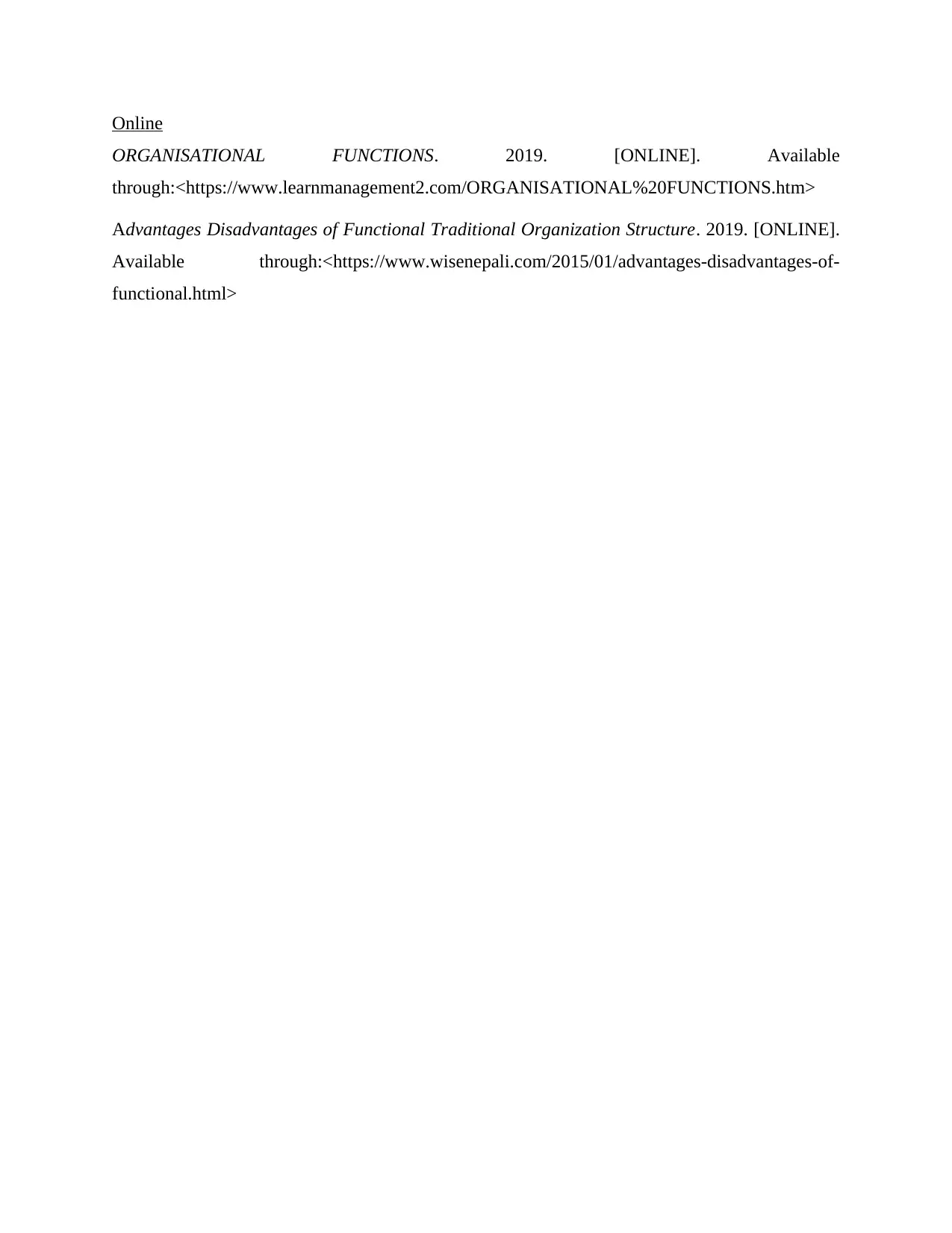
Online
ORGANISATIONAL FUNCTIONS. 2019. [ONLINE]. Available
through:<https://www.learnmanagement2.com/ORGANISATIONAL%20FUNCTIONS.htm>
Advantages Disadvantages of Functional Traditional Organization Structure. 2019. [ONLINE].
Available through:<https://www.wisenepali.com/2015/01/advantages-disadvantages-of-
functional.html>
ORGANISATIONAL FUNCTIONS. 2019. [ONLINE]. Available
through:<https://www.learnmanagement2.com/ORGANISATIONAL%20FUNCTIONS.htm>
Advantages Disadvantages of Functional Traditional Organization Structure. 2019. [ONLINE].
Available through:<https://www.wisenepali.com/2015/01/advantages-disadvantages-of-
functional.html>
1 out of 10
Related Documents
Your All-in-One AI-Powered Toolkit for Academic Success.
+13062052269
info@desklib.com
Available 24*7 on WhatsApp / Email
![[object Object]](/_next/static/media/star-bottom.7253800d.svg)
Unlock your academic potential
Copyright © 2020–2025 A2Z Services. All Rights Reserved. Developed and managed by ZUCOL.




